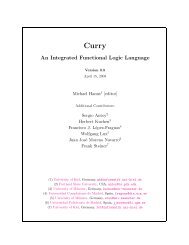Conformal Geometric Algebra in Stochastic Optimization Problems ...
Conformal Geometric Algebra in Stochastic Optimization Problems ...
Conformal Geometric Algebra in Stochastic Optimization Problems ...
Create successful ePaper yourself
Turn your PDF publications into a flip-book with our unique Google optimized e-Paper software.
42 CHAPTER 2. GEOMETRIC ALGEBRA<br />
Def<strong>in</strong>ition 2.5 (Blade ):<br />
The outer product of a set of 0 ≤ k ≤ n l<strong>in</strong>early <strong>in</strong>dependent vectors {a 1...k } ⊂ � p,q<br />
is called a blade of grade k or simply k-blade. It is denoted by A 〈k〉 .<br />
A 〈k〉 = a1 ∧ a2 ∧ ... ∧ ak<br />
A scalar is considered as a blade of grade 0.<br />
Subsequently, every appearance of blades A 〈k〉 , B 〈l〉 , etc will implicitly stand for<br />
� k<br />
i=1 ai, � l<br />
i=1 bi, etc if no deviant declaration is given.<br />
As a matter of course, every blade is a certa<strong>in</strong> κ-vector, which is why every computation<br />
rule for κ-vectors is applicable to blades as well. Likewise, any κ-vector<br />
A [k] is a k-blade A 〈k〉 iff it has an outer product representation a1 ∧ a2 ∧ ...∧ak.<br />
Example 2.4 ( κ-vector vs. blade ):<br />
(e1 + e2) ∧ (e2 + e3) ⇐⇒ e1e2 + e1e3 + e2e3 blade<br />
?? ⇐= e1e2 + e1e3 + e2e4 κ-vector.<br />
On page 23 it is stated that the outer product a ∧ b, n > 2, represents a l<strong>in</strong>ear 2Dsubspace,<br />
i.e. a plane. In addition, it is shown on page 32 that the outer product<br />
of vectors is zero if the vectors are l<strong>in</strong>early dependent. Hence the outer product of<br />
a vector x with a blade A 〈k〉 = �k i=1 ai is zero if the vectors {x,a1,a2,...,ak} are<br />
l<strong>in</strong>early dependent, or rather if x lies <strong>in</strong> the k-dimensional subspace spanned by the<br />
{a1...k }. The spann<strong>in</strong>g vectors are of course termed the basis or the frame of the<br />
subspace.<br />
Corollary 2.7<br />
A blade A 〈k〉 = � k<br />
i=1 ai represents a l<strong>in</strong>ear k-dimensional subspace <strong>in</strong> that<br />
x ∧ A 〈k〉 = 0 ⇐⇒ x lies <strong>in</strong> the span of the {a 1...k }<br />
for every vector x ∈ � p,q<br />
Proof: An outl<strong>in</strong>e for a direct proof of the ‘only-if’ direction is given on page 32.<br />
The ‘if’ direction can be deduced from equation (2.31): let x ∈ � n and A ∈ � n×k be<br />
the matrices, the columns of which hold the coefficients of x ∈ � p,q and A 〈k〉 ∈ �p,q,<br />
respectively. Then x ∧ A 〈k〉 may be expressed as<br />
x ∧ A 〈k〉 = �<br />
v∈I k+1/n<br />
det([x, A]|v) ev1ev2 ...evk+1 ,<br />
where [x,A] ∈ � n×k+1 symbolizes the horizontal concatenation of the matrices x<br />
and A. If at least one k+1-m<strong>in</strong>or det([x, A]|v) was non-zero, the matrix [x, A] would<br />
�
















